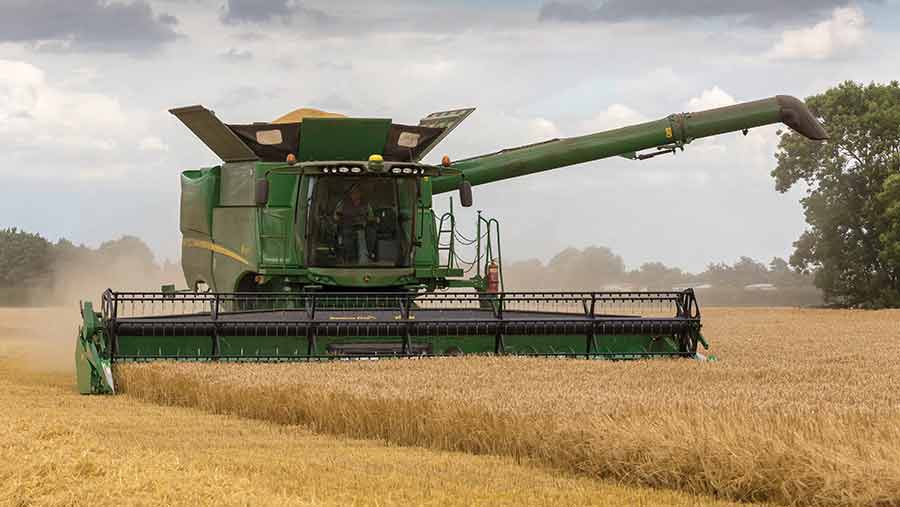Harvest 2023: Late-cut spring barley struggles for yield
 © Tim Scrivener
© Tim Scrivener Spring barley is proving to be an average-yielding crop this year, with some areas struggling more than others to achieve low nitrogen grain contents to meet malting quality.
See also: Harvest 2023: Wheat nearly done but some spring barley to cut
Northumberland
In north-east England, Simpsons Malt is 25-30% through its spring barley intake, dramatically behind this time last year, when harvest was 80-85% complete.
“From a quality perspective, the crop so far is variable – both nitrogen content and skinned corn counts are much higher than last year,” says Mike Dagg, senior grain trader.
A combination of late drilling and a dry April and May meant nitrogen went into the ear, not the plant, boosting some nitrogen contents.
“We have had to amend intake parameters in order to accept a higher percentage of this year’s crop,” says Mike.
Norfolk
Further south, Dewing Grain’s stores are close to capacity, with just some wheat and beans left to come in. “Spring malting barley quality is down compared with other years,” says grain trader Josh Dewing.
“We’ve seen some issues with pre-germination and screenings,” he says. The spring barley is averaging 15.2% moisture, 1.54% nitrogen and 62.7kg/hl specific weight, with screening retentions at 85.3%, compared with 92.3% last year.
“Diablo has a lower nitrogen content and better screenings, but the variety that all the maltsters would like is Laureate. But we’re seeing more issues generally with Laureate,” adds Josh.
Milling wheat quality is also suffering, with Hagberg quality losses due to the wet weather.
When it comes to oilseed rape, growers reduced the amount grown after bad yields last year, and average oil contents are 43%, compared with 44.5% last year.
Cambridgeshire
It’s a similar story at Camgrain, with the wheat harvest in the final stages.
Milling wheat qualities have remained intact as growers pushed on early.
“We had lots of showers and tricky weather, but they were able to go combining and secure those crops, which was important,” says Philip Darke, operations director at the grain co-operative.
Hagbergs are higher than 250, and protein content is slightly up from last year.
Spring oats have been coming in for the past three weeks and will be complete by the end of this week if weather allows. Quality has been fine with specific weights averaging 52-53kg/hl.
Oilseed rape has been disappointing due to establishment challenges.
“It would be nice if rapeseed had performed a little bit better; we might have more growers considering whether rape is the crop for them,” says Philip. The rapeseed that is in store averages more than 44% oil content.
Gloucestershire
Further west, it has been a horrendous harvest for Tim Morris at Coneygar Farm, near Cirencester, as the weather has done him no favours.
His 28ha of Ambassador oilseed rape was a good start to harvest, yielding 4t/ha at 44% oil content.
But 50ha of Laureate was the worst-performing spring barley for 20 years, with 150mm of rain in March and then drought in May and June ruining the crop.
It yielded less than 5t/ha but made malting quality, with a low nitrogen content and good retentions, and 100% germination.
His 150ha of Mascani winter oats were a mess due to wind damage. However, the average yield was over 6t/ha and the crop hit market specification at more than 51kg/hl specific weight.
Tim still has still a lot of winter wheat to cut. It is yielding 9t/ha so far, but the rain keeps coming just as he wants to start combining again.
Most of his crops have come in at 15% moisture content, and he has sent 700t to Camgrain.
Northern Ireland
At Broglasgow House, Myroe, County Londonderry, harvest is 60% complete, with 60ha of spring barley still a week away from being ready to combine. It looks as if it will be an average crop.
Richard Kane has cut 80ha of Orwell winter barley, at 20-22% moisture, which yielded 7t/ha. “The ground conditions were awful – it was a bit of a disaster,” he says.
Oilseed rape variety Dart yielded 3.75t/ha, and will be crushed on-farm for bottling. Also combined is 88ha of winter wheat, with Graham yielding well at 10t/ha and Dawsum for seed production at 11t/ha.
“Weed control has been awful, I think the drought in June seemed to cause secondary weed growth,” says Richard.
